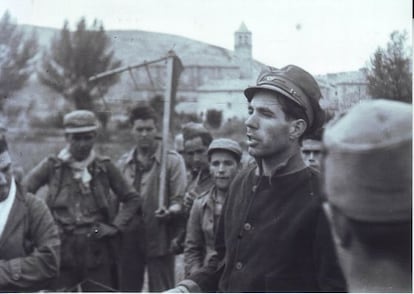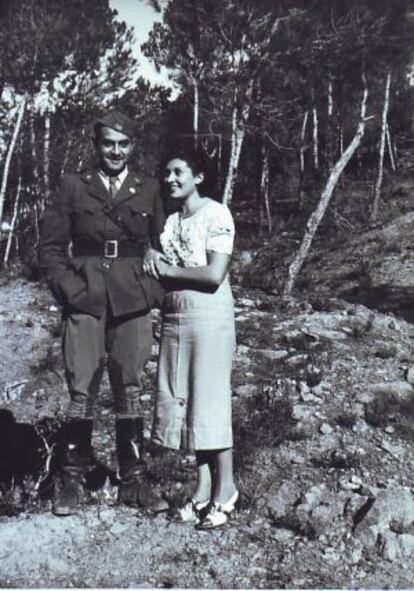The Civil War seen through unknown eyes
Hundreds of never-before-viewed negatives taken by an anonymous photographer provide a glimpse of daily life during the Spanish conflict


In July 2010, Barcelona-based auction house Soler y Llach put a collection of close to 1,400 negatives up for sale, the majority of them images from the Spanish Civil War taken by an anonymous photographer that had ended up in the South of France. They captured daily life among the Republican forces in Catalonia and Aragon, with images of militias, training camps, soldiers in the trenches and interrogations of prisoners, as well as tanks going into battle along the River Segre in Catalonia.
Also among the previously unseen photographs were insights into life in the years leading up to the conflict: bathers at the seaside resort of Sitges, crowds on the streets during the elections of 1931, as well as events during the revolution in October 1934 in Barcelona, all neatly collated in three small boxes.
The starting price for the lot was 25,000 euros, but there were no bidders. Then, last week, the Dignity Commission, an association that campaigns for the return of Civil War documents now stored at the national archive in Salamanca to be returned to Catalonia, announced that it had bought the collection for 7,500 euros on the internet. Josep Cruanyes, the association's spokesman, said the negatives belonged to a photographer who traveled with the 30th Division of the Republican Army. At the end of the war, they were taken to France.
The identity of the photographer remains unknown. "We bought them through an intermediary in Barcelona who acquired them from a retired soldier in his eighties living in Perpignan, the son of another member of the armed forces who went into exile and lived for some time in the refugee camps in France," says Cruanyes, adding that in his view the images are "better" than anything by "the war correspondents who visited the front occasionally."

The unidentified photographer used two cameras: a Leica, and another that took 3x4 centimeter film, suggesting that he or she was a professional.
Among the place names carefully annotated are the scenes of some of the bitterest fighting in the conflict: Grañén and Berdegal in Huesca; the Badaüll ravine at Llimiana, Montgai, Baldomà, Linyola and Sanahuja in Lleida; and Martín de Río in Teruel. There are photographs of the unit led by Víctor Torres, the 146th Mixed Brigade, as well as of the XI Corps of the Republican Army, led by Lieutenant Colonel Felipe Galán.
The regional government of Catalonia turned the collection down, saying the quality of the images was poor. The Dignity Commission raised 10,000 euros to buy the photographs and have them studied by a team that will be advised by the Catalan National Archive, which will take charge of the negatives. An exhibition is planned, as well as a book. Cruanyes says he believes the photographer is Andreu Puig Farran, who died in 1982. "The movements of this photographer coincide with the dates of these images: Puig was at the front and ended up going into exile with his archive."
But Cruanyes admits that it is still too early to draw any definitive conclusions about who took the photographs, and that a detailed study of the images is needed. The same woman appears in several of the photographs, identified as Maria Fabregat. In one she is standing next to a sergeant in the Republican Army, standing in a doorway — a man who might just be Andreu Puig Farran.
Tu suscripción se está usando en otro dispositivo
¿Quieres añadir otro usuario a tu suscripción?
Si continúas leyendo en este dispositivo, no se podrá leer en el otro.
FlechaTu suscripción se está usando en otro dispositivo y solo puedes acceder a EL PAÍS desde un dispositivo a la vez.
Si quieres compartir tu cuenta, cambia tu suscripción a la modalidad Premium, así podrás añadir otro usuario. Cada uno accederá con su propia cuenta de email, lo que os permitirá personalizar vuestra experiencia en EL PAÍS.
¿Tienes una suscripción de empresa? Accede aquí para contratar más cuentas.
En el caso de no saber quién está usando tu cuenta, te recomendamos cambiar tu contraseña aquí.
Si decides continuar compartiendo tu cuenta, este mensaje se mostrará en tu dispositivo y en el de la otra persona que está usando tu cuenta de forma indefinida, afectando a tu experiencia de lectura. Puedes consultar aquí los términos y condiciones de la suscripción digital.
Últimas noticias
The complicated life of Francesca Albanese: A rising figure in Italy but barred from every bank by Trump’s sanctions
How Japan is trying to avert ‘digital defeat’
Reinhard Genzel, Nobel laureate in physics: ‘One-minute videos will never give you the truth’
Pinochet’s victims grapple with José Antonio Kast’s rise in Chile
Most viewed
- Pablo Escobar’s hippos: A serious environmental problem, 40 years on
- Why we lost the habit of sleeping in two segments and how that changed our sense of time
- Trump’s obsession with putting his name on everything is unprecedented in the United States
- The Florida Keys tourist paradise is besieged by immigration agents: ‘We’ve never seen anything like this’
- Charles Dubouloz, mountaineering star, retires at 36 with a farewell tour inspired by Walter Bonatti








































